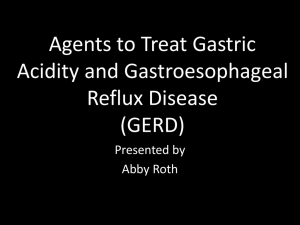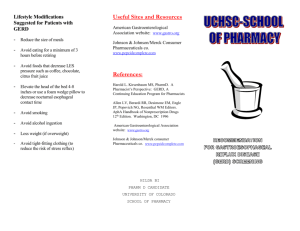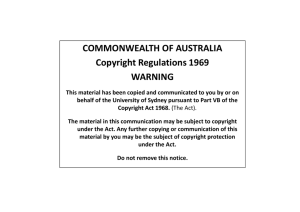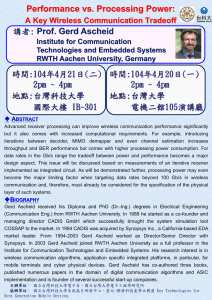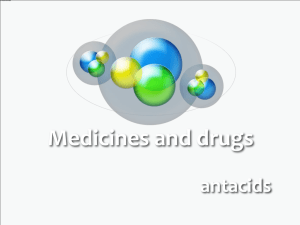DH206: pharmacology Chapter 15 gi drugs
advertisement
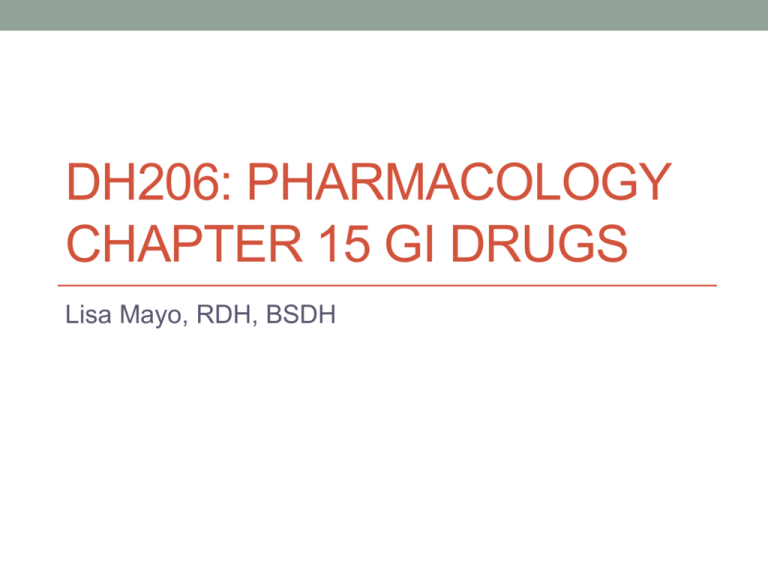
DH206: PHARMACOLOGY CHAPTER 15 GI DRUGS Lisa Mayo, RDH, BSDH GI Drugs HCl formation in stomach occurs in parietal cells of the stomach (pH=1.0-2.0) HCO3- leaves parietal cell Cl- enter parietal cell & combo with H+ = HCl Gastrointestinal Drugs GI Diseases 1. Gastroesophageal reflux disease (GERD) 2. Peptic ulcer disease (PUD) 3. Chronic inflammatory bowel: Ulcerative colitis, Crohn’s 4. Constipation 5. Diarrhea 6. Nausea & Emesis(vomiting) **The GI tract is highly susceptible to emotional changes because it is innervated by the VAGUS nerve associated with the ANS** 1. Gastroesophageal Reflux Disease • GERD, or “heartburn,” is the most prevalent GI disease in U.S. • Stomach contents flow back up into the esophagus through the cardiac sphincter which is not functionally correctly • Irritation, inflammation, erosion occur because esophagus not designed to handle the levels of acids in the stomach • Pain may be severe & felt in middle of chest 1. Gastroesophageal Reflux Disease • Risk factors • Alcohol use • Smoking • Spicy foods • Stomach ulcers • Meds: Aspirin, NSAIDs, CCB, Fosamax, Tetracycline • Symptoms exacerbated by: • Supine position • Large meals • Long-term complication = Barrett’s esophagus 1. Gastroesophageal Reflux Disease Treatment • Lifestyle changes • Avoid eating for 4 hours prior to bed • Eat smaller meals • Pillow while sleeping • Drugs therapy 1. Antacids 2. H2-antagonists 3. Proton-pump inhibitors (PPIs) 4. GI stimulants 2. Peptic Ulcer Disease (PUD) • Peptic ulcer: circumscribed loss of tissue or break that occurs in the GI mucosa extending through the smooth muscle that lines the GI tract • Occurs when imbalance of: 1. Gastric acid 2. Pepsin 3. Mucosal defense factors prostaglandins • Dental Management: p.187, Box 15-1 • Etiology 1. Helicobacter pylori (gram (-) & alters inflammatory response) • Combo Tx of 2 ABX + H2-blocker/PPI 2. Long-term aspirin/NSAID or corticosteroid use 2. Treatment PUD 1. Same as GERD plus: 2. Prostaglandins 3. Protective barriers 4. ABX: H.pylori NBQ Which of the following risk factors are primarily involved in causing peptic ulcer disease? a. Smoking & alcohol b. Caffeine & smoking c. H.pylori and NSAIDs d. S.mutans and alcohol NBQ Which of the following risk factors are primarily involved in causing peptic ulcer disease? a. Smoking & alcohol b. Caffeine & smoking c. H.pylori and NSAIDs d. S.mutans and alcohol 3. Chronic Inflammatory Bowel Disease (IBD) 2 categories of inflammation 1) Ulcerative colitis: sores in mucosal of colon/rectum 2) Crohn’s Disease: inflammation spreads deep into affected tissues • Smoking cessation may exacerbate 3. Chronic Inflammatory Bowel Disease (IBD) DRUGS FOR TX FIBER SUPPLEMENTS 1st ANTIINFLAMMATORY Sulfasalzine(Azulfidine) Mesalamine(Apriso) Balsalazide(Colazal) Olsalazine(Dipentum) CORTICOSTEROIDS Prednisone IMMUNOSUPPRESSANT 6-mercaptopurine(Purinethol) Azathioprine(Imuran) Cyclosporine ANTIDIARRHEAL Imodium ANTISPASMODICS Anticholinergics TNF-ALPHA NUETRALIZER Infliximab(Remicade) 4. Constipation Risk factors 1) Narcotics 2) Anticholinergics 3) CCB 4) Aluminum-containing antacids 5) Iron products p.190 Agents Drugs Bulk-forming laxatives Methycellulose, polycarbophil, psyllium Watery evacuation (osmotic/saline laxative) Magnesium Lubricant Mineral oil Soften stool/Emollients Disacodyl sodium sulfosuccinate 5. Diarrhea Etiology • Most common bacterial causes: Salmonella, E.coli • ABX: broad-spectrum most common • NSAIDs, Diuretics, Antihistamines (H2-inhibitors), Digoxin DRUGS NOTATIONS Ioperamide(Imodium) Diphenoxylate + Atropine (Lomotil) Opiate + Anticholinergic Bismuth subsalicylate(Pepto-Bismol, Keopectate) Traveler’s diarrhea (NBQ) Yogurt or acidophilus Use when on broad-spectrum ABX Yogurt 2hrs before tetracycline (NBQ) NBQ All of the following drugs reduce GI motility and are used to treat diarrhea EXCEPT which one? a. Loperamide(Imodium) b. Bismuth subsalicylate(Pepto-Bismol) c. Furosemide(Lasix) d. Diphenoxylate and atropine(Lomotil) e. Attapulgite(Kaopectate) NBQ All of the following drugs reduce GI motility and are used to treat diarrhea EXCEPT which one? a. Loperamide(Imodium) b. Bismuth subsalicylate(Pepto-Bismol) c. Furosemide(Lasix) Loop diuretic for HBP d. Diphenoxylate and atropine(Lomotil) e. Attapulgite(Kaopectate) NBQ Which of the following drugs has the potential to cause severe diarrhea? a. Clindamycin b. Ciaspride c. Diazepam d. Metronidazole e. Vancomycin NBQ Which of the following drugs has the potential to cause severe diarrhea? a. Clindamycin b. Ciaspride c. Diazepam d. Metronidazole e. Vancomycin 6. Nausea & Emesis • NO Clindy • Drugs used to tx 1) 2) 3) 4) Anticholinergic Antiemetic Depress chemoreceptor trigger zone Cannabinoids DRUG CLASS DRUGS Phenothiazide Phenergan, Compazine Anticholinergic Dramamine, Bonine Block chemoreceptor trigger zone Zofran, Anzemet, Tigan I Promise I Won’t Do This to You!!! Drugs Used to Treat GI Diseases Acid Neutralizers 1. Antacids Antisecretory Drugs: Receptor-Mediated Drug Action 1. Antihistamines (H2-blocking agents) 2. PPIs 3. Prostaglandins 4. GI stimulants Protective Barrier Drugs 1. Sucralfate(Carafacte) Drugs Used to Treat GI Diseases Acid Neutralizers 1. Antacids Antisecretory Drugs: Receptor-Mediated Drug Action 1. Antihistamines (H2-blocking agents) 2. PPIs 3. Prostaglandins 4. GI stimulants Protective Barrier Drugs 1. Sucralfate(Carafacte) Acid Neutralizers P.189 Antacids Used to relieve the pain & indigestion Many brands OTC: magnesium, aluminum, calcium Oldest antacid: sodium bicarb (Alka-Seltzer) but can create alkalosis, cannot be used by cardiac patients Pepto-Bismol: used in tx PUD Acid Neutralizers Antacid Use Calcium carbonate(Tums, Maalox) GERD Magnesium hydroxide(Milk of Magnesium) GERD Aluminum/magensium hydroxide/simethicone(Maalox, Mylanta) GERD Calcium carbonate/magensium hydroxide(Rolaids) GERD Sodium bicarbonate (Gaviscon) GERD Bismuth subsalicylate(Pepto-Bismol) PUD H.pylori Acid Neutralizers Antacids Action: Basic salts Neutralize HCl acids in stomach Raise pH of stomach Can alter absorption of MANY other drugs Short duration (30min) Guidelines for Patients Antacids taken 2hrs prior to tetracycline (CH7) Hypertensive pt’s: avoid sodium-based antacids NBQ Which of the following GI drugs should not be given concurrently with doxycycline? a. Omeprazole b. Cimetidine c. Antacids d. Lansoprazole NBQ Which of the following GI drugs should not be given concurrently with doxycycline? a. Omeprazole b. Cimetidine c. Antacids d. Lansoprazole Drugs Used to Treat GI Diseases Acid Neutralizers 1. Antacids Antisecretory Drugs: Receptor-Mediated Drug Action 1. Antihistamines (H2-blocking agents) 2. PPIs 3. Prostaglandins 4. GI stimulants Protective Barrier Drugs 1. Sucralfate(Carafacte) Drugs Used to Treat GI Diseases Antisecretory Drugs: Receptor-Mediated Drug Action 1. Antihistamines (H2-blocking agents) P-450 inhibitors – MANY drug 2. PPIs interactions 3. Prostaglandins: Misoprostol 4. GI stimulants: Metoclopramide Parietal cell are the site of action of Antihistamines, PPI, Prostaglandins Drugs Used to Treat GI Diseases Antisecretory Drugs: Receptor-Mediated Drug Action 1. H2-blocking agents Histamine Review Histamine located in GI mucosa within mast cells Histamine Receptors (called H2-receptors) Mediate secretion of gastric acid & pepsin Located in parietal cells of the GI system (parietal cells produce acids) H2 stimulation = parietal cells release more acids (↓pH) If block receptors: reduce acid & pepsin production Parietal cells (secrete histamine) Site of action of antihistamines ↓ Reduce acid & pepsin production Drugs Used to Treat GI Diseases Antisecretory Drugs: Receptor-Mediated Drug Action 1. Antihistamines • Inhibit P-450 – interact with MANY drugs (NBQ) • Similar onset of action to antacids (quick) but longer duration of action All end in ~tidine • Uses: PUD & GERD Antihistamines cimetidine(Tagamet) PROTYPE Ranitidine(Zantac) Famotidine (Pepcid, Mylanta AR) Nizatidine(Axid) Drug interactions due to CYP1A2 liver metabolism Do NOT use more than 6wks (agranulocytosis, diarrhea) Drugs Used to Treat GI Diseases Antisecretory Drugs: Receptor-Mediated Drug Action 2. PPIs • Drug of choice for patients with daily symptoms or those not responding to antihistamines • Reduce peak acid output • Achieve almost total suppression of acid secretion because they bind irreversibly to parietal cells • Many drug interactions (P-450 inhibition) (NBQ) Guidelines for Patients Valium & Dilantin interactions No aspirin Xerostomia Drugs Used to Treat GI Diseases Antisecretory Drugs: Receptor-Mediated Drug Action PPIs PPIs Omeprazole(Prilosec) Omeprazole/sodium bicarbonate(Zegerid) Lansoprazole(Prevacid) Esomeprazole(Nexium) Rabeprazole(AcipHex) Pantoprazole(Protonix) Rabeprazole(AcipHex) PROTYPE Drugs Used to Treat GI Diseases Antisecretory Drugs: Receptor-Mediated Drug Action 3. Prostaglandins: Misoprostol(Cytotec) p.189 • Synthetic prostaglandin (PGE2α) • Management of NSAID/Aspirin-induced ulcers • Inhibits gastric acid secretions • Increases gastric mucosal defenses • Pregnancy category X Drugs Used to Treat GI Diseases Antisecretory Drugs: Receptor-Mediated Drug Action 4. GI stimulants: Metoclopramide(Reglan) • Stimulates contraction of the lower esophageal sphincter by enhancing action of ACH (acetylcholine) ↓ • Decrease reflex gastric juices back into esophagus • GERD ONLY, not PUD NBQ Which 3 GI drugs below reduce the formation of stomach acid by inhibiting the proton pump of the stomach parietal cells? a. Ranitidine(Zantac) b. Esomeprazole(Nexium) c. Famotidine(Pepcid) d. Omeprazole(Prilosec) e. Lansoprazole(Prevacid) NBQ Which 3 GI drugs below reduce the formation of stomach acid by inhibiting the proton pump of the stomach parietal cells? a. Ranitidine(Zantac) b. Esomeprazole(Nexium) c. Famotidine(Pepcid) d. Omeprazole(Prilosec) e. Lansoprazole(Prevacid) Drugs Used to Treat GI Diseases Acid Neutralizers 1. Antacids Antisecretory Drugs: Receptor-Mediated Drug Action 1. Antihistamines (H2-blocking agents) 2. PPIs 3. Prostaglandins 4. GI stimulants Protective Barrier Drugs 1. Sucralfate(Carafacte) Barrier Enhancer Sucralfate(Carafate) • Complex of aluminum hydroxide + sulfated sucrose • “Bandage” over ulcer • PUD short-term tx • Forms a protective barrier over damaged mucosa, binds to PRO in ulcers • Inhibits the action of pepsin • Absorbs bile salts that can cause irritation of the gastric lining • Most common side effect: constipation Summary Tx for PUD/GERD PUD TX 2 ABX + Antihistamine + Antacid GERD TX Antacid + Antihistamine/PPI NBQ Which of the following drugs is best for starting initial treatment of mild, intermittent heartburn? a. Sodium bicarbonate/alginic combination b. Cimetidine c. Omeprazole d. Lansoprazole NBQ Which of the following drugs is best for starting initial treatment of mild, intermittent heartburn? a. Sodium bicarbonate/alginic combination b. Cimetidine c. Omeprazole d. Lansoprazole
